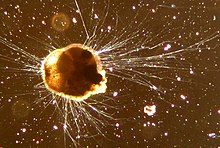| Rhizaria Temporal range:
| |
|---|---|

| |
| Ammonia tepida (Foraminifera) | |
| Scientific classification | |
| Domain: | Eukaryota |
| Clade: | Diaphoretickes |
| Clade: | TSAR |
| Clade: | SAR |
| Clade: | Rhizaria Cavalier-Smith, 2002 |
| Phyla[2] | |
The Rhizaria are a diverse and species-rich supergroup of mostly unicellular[3] eukaryotes.[4] Except for the Chlorarachniophytes and three species in the genus Paulinella in the phylum Cercozoa, they are all non-photosynthetic, but many foraminifera and radiolaria have a symbiotic relationship with unicellular algae.[5] A multicellular form, Guttulinopsis vulgaris, a cellular slime mold, has been described.[6] This group was used by Cavalier-Smith in 2002, although the term "Rhizaria" had been long used for clades within the currently recognized taxon.
Being described mainly from rDNA sequences, they vary considerably in form, having no clear morphological distinctive characters (synapomorphies), but for the most part they are amoeboids with filose, reticulose, or microtubule-supported pseudopods. In the absence of an apomorphy, the group is ill-defined, and its composition has been very fluid. Some Rhizaria possess mineral exoskeletons (thecae or loricas), which are in different clades within Rhizaria made out of opal (SiO2), celestite (SrSO4), or calcite (CaCO3).
Certain species can attain sizes of more than a centimeter with some species being able to form cylindrical colonies approximately 1 cm in diameter and greater than 1 m in length. They feed by capturing and engulfing prey with the extensions of their pseudopodia; forms that are symbiotic with unicellular algae contribute significantly to the total primary production of the ocean.[7]
- ^ Cite error: The named reference
RhizariaPhylo2018was invoked but never defined (see the help page). - ^ Sina M. Adl; David Bass; Christopher E. Lane; et al. (1 January 2019). "Revisions to the Classification, Nomenclature, and Diversity of Eukaryotes". Journal of Eukaryotic Microbiology. 66 (1): 4–119. doi:10.1111/JEU.12691. ISSN 1066-5234. PMC 6492006. PMID 30257078. Wikidata Q57086550.
- ^ Taylor, Christopher (2004). "Rhizaria". Archived from the original on 2009-04-20.
- ^ Nikolaev, Sergey I.; Berney, Cédric; Fahrni, José F.; et al. (May 2004). "The twilight of Heliozoa and rise of Rhizaria, an emerging supergroup of amoeboid eukaryotes". PNAS. 101 (21): 8066–71. doi:10.1073/pnas.0308602101. PMC 419558. PMID 15148395.
- ^ Gast, Rebecca J.; Caron, David A. (2001-10-01). "Photosymbiotic associations in planktonic foraminifera and radiolaria". Hydrobiologia. 461 (1): 1–7. doi:10.1023/A:1012710909023. S2CID 1387879.
- ^ Brown, Matthew W.; Kolisko, Martin; Silberman, Jeffrey D.; Roger, Andrew J. (June 2012). "Aggregative Multicellularity Evolved Independently in the Eukaryotic Supergroup Rhizaria". Current Biology. 22 (12): 1123–7. Bibcode:2012CBio...22.1123B. doi:10.1016/j.cub.2012.04.021. PMID 22608512.
- ^ Caron DA (April 2016). "Ocean science: The rise of Rhizaria". Nature. 532 (7600): 444–5. Bibcode:2016Natur.532..444C. doi:10.1038/nature17892. PMID 27096370.